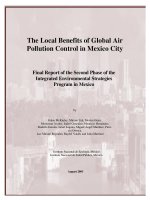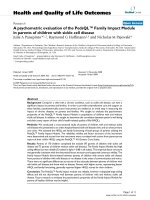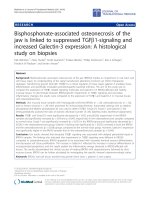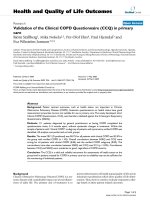Curriculum renewal of the Advanced t Training Program in Architecture – Hanoi Architectural University
Bạn đang xem bản rút gọn của tài liệu. Xem và tải ngay bản đầy đủ của tài liệu tại đây (557.02 KB, 5 trang )
Curriculum renewal of the Advanced tTraining Program
in Architecture – Hanoi Architectural University
Đổi mới chương trình đào tạo – Chương trình Tiên tiến ngành Kiến trúc công trình Trường Đại học Kiến trúc Hà Nội
Le Chien Thang
Tóm tắt
Chương trình Tiên tiến ngành Kiến trúc (CTTT) của trường
ĐH Kiến trúc Hà Nội là một trong những chương trình
thành công trong đề án của Bộ Giáo dục và Đào tạo. Sau
9 năm hoạt động, CTTT đã đạt được một số mục tiêu đề
ra góp phần nâng cao chất lượng đào tạo, đội ngũ giảng
viên, cán bộ quản lý... Trong bối cảnh toàn cầu hóa giáo
dục hiện nay, cạnh tranh trong môi trường đào tạo ngày
càng khốc liệt cả trong và ngoài nước, các trường đào tạo
chuyên ngành kiến trúc cũng đang rất tích cực và chủ động
xây dựng các chương trình đào tạo theo hướng quốc tế hóa
nhằm thu hút sinh viên và nâng cao uy tín của mình. Do đó
đổi mới chương trình đào tạo là điều cần thiết. Bài báo này
sẽ đề xuất khung chương trình đào tạo mới cho CTTT trên
cơ sở đánh giá hiện trạng cũng như tham khảo các chương
trình đào tạo tiên tiến khác trên thế giới.
Từ khóa: Đổi mới chương trình, quốc tế hoá, thiết kế bền
vững
Abstract
The Advanced Training Program in Architecture (CTTT) of Hanoi
Architectural University is one of the successful programs in
the Ministry of Education and Training project. After 9 years,
the program has achieved a number of goals that contribute
to improve the quality of training, teaching, managing... In
the context of the globalization of education today, training
competition both in Vietnam and abroad increases rapidly, other
architectural training institutions are also very active in building
training programs towards internationalization to attract students
and enhance their reputation. Therefore, renewal of the curriculum
- CTTT should be implemented immediately. This paper proposes a
new curriculum framework based on the current situation as well
as other advanced training programs in the world.
Key words: curriculum renewal, internationalization, sustainable
design
Dr.Arch. LE Chien Thang
Institute for International Training and Cooperation
Tel: 0947878818
Ngày nhận bài: 08/5/2018
Ngày sửa bài: 15/5/2018
Ngày duyệt đăng: 05/7/2018
1. Current status of the Advanced Training Program at Hanoi
Architectural University
1.1. Overview:
The Advanced Training Program at Hanoi Architectural University
(CTTT-HAU) was part of a national project funded by the Ministry of
Education and Training “Advanced training at some universities in
Vietnam in the period of 2008-2015” which was approved by Official
Letter No. 8653 / QD-BGDDT dated 24/12/2008. Since 2009, the
CTTT-HAU started enrollment. The annual enrollment was almost
reaching the target with an average of 53 students per year (currently
a total of 421 students). The CTTT-HAU was based on the original
curriculum and participation of managers, lecturers and experts of the
University of Nottingham (UK) - ranked joint 70th in the world 2008
especially in the field of built environment, and Hanoi Architectural
University. Therefore, the CTTT-HAU had more advantages than
other Vietnamese architecture programs at that time. This program
was also in line with the general requirements of the Ministry of
Education and Training’s curriculum framework. The total credit
number was 244 and consisted of 31 credits of General education
knowledge (accounting for 12.7%), 56 credits of Basic professional
knowledge (23%), 157 credits of Professional knowledge (64.3%) of
which 86 credits of Design studio (35.2%).
1.2. Advantages:
The CTTT-HAU was well recognized by many international
universities for its quality, enabling CTTT-HAU students to exchange
to the others. Subjects were updated with advanced international
training programs. The program also offered students access to a
wide range of professional information, helped students meet the
diverse needs of the labor market. The program was built on the core
of the Design studio system and issues related to social and natural
environments. Besides the socio-cultural and technological subjects,
environmental subjects and related issues between the environment
and architecture were gradually emphasized to create the program’s
own identity in accordance with the modern trend in architectural
training.
1.3. Disadvantages:
However, the program also revealed some certain inadequacies,
especially the 6-year training period, which was losing its
competitiveness. The program’s total credits as well as the credits/
semester were too much (5 semesters were 19 and 20 credits/
semester, the highest was 27 credits/semester). Moreover, the credit
attribution per semester was unbalance (the lowest was 12 credits/
semester and the highest was 27 credits/semester), which caused
difficulties for students from semester 3 to 7 to catch up with the
program process. All subjects of General education knowledge, no
Basic professional knowledge and Professional knowledge, were
arranged in the first two semesters, made students lose interest
in starting their studies before commencing very tough next year.
In addition, such placement of General education knowledge and
S¬ 31 - 2018
29
KHOA H“C & C«NG NGHª
Professional knowledge would reduce the ability of transfer
to international partner institutions from the second year.
The Design studio quantity was high with a total of 17
studios (of which 16 studios in 9 semesters from 3rd to
11th semester, led to more than 2 studios/semester). Such
studio quantity and attribution was unreasonable with the
modern architecture training which usually had only 1 studio/
semester and had many small studios supporting the main
studio to help students had enough time to implement all
intensive requirements.
Major theoretical subjects of the Basic professional
knowledge and Professional knowledge were many. Some
subjects did not meet the technical quality in built environment
since they required supporting technical systems and in-depth
studies with full laboratories and experience professionals.
This did not bring efficiency in training.
2. Internationalization trends in education
The world economy has changed from the industrial to
the knowledge economy. Therefore, education reform is an
indispensable process. Internationalization is a global trend
arising from a globalized economy increasingly interconnected
and interdependent. While the world’s universities have
many years of internationalization experience, Vietnam
has just begun to build an international environment.
Therefore, internationalization requirements with Vietnam
are more urgent than experienced countries due to the
rapid shortening of the gap caused by backwardness and
isolation years earlier. Vietnamese students are more likely
to seek international universities, both at home and abroad.
With such demands, the internationalization of Vietnamese
universities is becoming a necessary requirement for
success, not only to attract students but also to improve
the quality of education and management as well as raise
funds for the universities. Since the opening strategies and
especially after the accession to the WTO, Vietnamese
higher education has been making significant progress in the
internationalization process with the establishment of many
international universities in Vietnam as well as international
investment in education has been rapidly increasing in recent
years. Within the scope of each university, in spite of different
levels, different forms of international cooperation in training
are increasingly diverse.
In addition, the internationalization trend in employment
also has a strong impact on Vietnam universities. Workers
have many opportunities to exchange and practice in different
countries. Architecture is also a sector with high labour
demand but the supply is still low, especially with high quality
architects in spite of more than 30 architectural university
today in Vietnam.
to then screen the majors according to the student’s level as
well as create conditions for students to transfer to another
schools or other disciplines. In Japan, architectural students
build their studies together for the first three years and are
assigned to the depths of the labs in the final year so that
students can learn all about architecture and engineering.
The types of training are plentiful, encouraging the
participation of different subjects, including non-majors,
thereby creating new training disciplines. Students can also
study in parallel and take multiple degrees together during
one study period, saving time, effort and money.
Quality assurance is strictly controlled at the school,
state, national and professional levels. Quality assurance not
only enhances the school’s reputation, gives students better
job opportunities in the labor market as well as facilitates
students’ transition to higher education.
Training content is also abundant, though all schools
have a central studio system with specialized subjects and
supplementary disciplines. Many schools combine technology
and design or architectural design with other types of designs
such as media, automation...
Theoretical subjects are built directly linked to the project
system. The subject areas of science, technology and
humanities are appropriately proportionate and arranged in
a gradual manner according to the year.
4. Proposal of curriculum framework – CTTT-HAU
4.1. Program outcome standards:
In addition to the general standards that have been
defined in the current Program outcome standards of
the current CTTT-HAU, including general knowledge,
professional knowledge, skills, attitude and job placement,
some additional points which will become the core values
in the new curriculum of CTTT-HAU: architectural design
and planning towards sustainable architecture and urban
development (1), capacity of approaching and handling
new issues in a creative and active ways (2), ability to work
in a dynamic international environment in the future (3).
Based on these, the new curriculum (subjects, structure…)
will be designed in accordance with the Program outcome
standards.
4.2. Training duration and knowledge:
The training duration is 5 years (10 semesters) with the
total cumulative credits for graduation is 174. They are:
-
General education
(accounting for 21%);
3. International architectural training programs
Universities worldwide are now very self-reliant in
developing their own training curriculum, although there are
similarities to facilitate student exchange. Schools in Europe
have completed the Bologna Process General Credit System
as well as in conjunction with American, Australian and Asian
institutions at certain levels. Some institutions have a fiveyear Diplomat system (Germany, Austria, Hungary ...), or
have 3 + 2 (3 year Bachelor and 2 year Master) programs
in parallel. Basically, the training time is from 3 to 5 years, of
which 2 to 3 years are for basic training, the following years
are for in depth studies.
Universities in the United States have 2 years of foundation
30
knowledge:
36
credits
-
Basic professional knowledge: 40 credits (23%)
-
Professional knowledge 98 credits (56%) of which
o
Design studio: 52 credits (30%).
o
Professional subjects: 46 credits (26%)
4.3. Curriculum design:
The curriculum is built on the basis of the survey of current
curriculum by faculty staff, students, alumni and employers,
as well as by the curriculum of several US and European
prestige universities. The curriculum design is to create an
internationally-recognized training program that develops
advanced skills in architectural design and gives students the
ability to develop specialized knowledge and skills related to
the field.
The five-year intensive training program is designed on
the basis of 174 credits, each of which includes a combination
T„P CHŠ KHOA H“C KI¦N TR”C - XŸY D¼NG
S¬ 31 - 2018
31
Contemporar
y Debates
Design (3)
Housing
Design
Principle (2)
Small scale
architecture
(4)
Descriptive
languages of
geometry (3)
Graphic
basics of
architecture
(3)
Representin
g method of
architecture
(3)
Structures &
Construction
1 (3)
Structure in
Architecture
(4)
Principle of
Enviromental
Design 1 (2)
Principle of
Enviromental
Design 2 (4)
Principle for
tall buildings
(2)
Tall building
(6)
Apartment
Building (3)
Housing
project (3)
Urban
planning (4)
Design theory Sustainability:
(3)
Principles and
Practice (3)
Urban Design
Theory (4)
History of
Architecturre
P1 (3)
Structures &
Construction 3
(3)
Semester 5
(26 credits)
Structures &
Construction 2
(4)
Design
Communicatio
n Techniques
(3)
Semester 2
Semester 3 Semester 4
(12 credits)
(27 credits) (19 credits)
Professional
foreign language
(3)
Fine Art P2 (3)
Physical
Excercise P2 (1)
Ho Chi minh
Ideology (2)
Fine Art P1 (2)
Physical
Excercise P1 (2)
Principle of
Marxist-Leninist
Philosophy P1 (2)
Principle of
Revolution lines
Marxist-Leninist
of Vietnam
Philosophy P2 (3) Communist
Party (3)
Military Education
(4)
Semester 1
(19 credits)
Advanced foreign
language (6)
Current curriculum of CTTT-HAU (total 244 credits):
General Education Knowledge (31)
Professional Knowledge Basic Professional Knowledge (71)
(63)
Design studio (79)
Practice and
Management
(3)
Urban Social
Issues (3)
Semester 7
(24 credits)
Industrial
project (5)
Industrial
project (4)
Principle of
Industrial
Architecture
(3)
Design Extra
(3)
Culture
Architecture
(4)
Principle for
Public
Architecture
(2)
Design for
Disabled
Theory (2)
Theory of
Landscape
Design (2)
Education
Architecture
(3)
Landscape
Design (2)
Field study (3) Theory and
Criticism of
Architecture
(3)
Spatial stories
(3)
Structures &
Construction 4
(3)
History of
Architecturre
P2 (3)
Semester 6
(27 credits)
Semester 9
(15 credits)
Sport
Architecture (5)
Transportation
Architecture (4)
Introduction to
Renewable
Energy (3)
Project:
Advanced
Technology
and Design (3)
Advanced
Technology
and Design (3)
Development
Finance (3)
Semester 10
(23 credits)
Design
Briefing (3)
Special
Emphasis (3)
Final Design
(19)
Semester 11 Semester 12
(15 credits) (19 credits)
Urban design (6) Multi-functional Pre-final
Architecture
design (9)
(5)
Apartment
regeneration
(6)
Theory of Green Urban Design
and Tropical
and
architecture (3) Regeneration
(3)
Principle of city
center (3)
Project
Management
Management & Practice and
Development (3) Law (3)
History of
Architecturre 3
(3)
Semester 8
(18 credits)
T„P CHŠ KHOA H“C KI¦N TR”C - XŸY D¼NG
Basic Professional
Knowledge (40)
Design Professional Knowledge
studio (46)
(52)
32
General Education
Knowledge (36)
Field study (3)
Architecture &
Environment 1
(4)
History of
architecture &
urbanism 1 (3)
Semester IV
(19 credits)
Professional
foreign
language (3)
Design
principles of
Spatial stories residential
(3)
building (2)
Principle for
Design Extra interior design
(2)
(3)
Basic design Architectural
Architectural Architectural
studio 1 (3)
design studio 1 design studio design studio
(3)
2 (4)
3 (5)
Introduction of
sustainable
architecture (2)
Design theory
(2)
Semester II
Semester III
(18 credits)
(18 credits)
Advanced
foreign language
2 (3)
Physical
Excercise P1 (1)
Principle of
Principle of
MarxistMarxist-Leninist
Leninist
Philosophy P2
Philosophy P1 (3)
(2)
Drawing 1 (3) Drawing 2 (2)
Architectural
compositions
(3)
Descriptive
Computer
languages of Applications in
geometry (4) Design 1 (2)
Design
Structure &
communicatio
construction 1
n techniques
(2)
(2)
Semester I
(17 credits)
Advanced
foreign
language 1 (3)
Proposed new curriculum – CTTT-HAU (174 credits):
Semester VII
(18 credits)
Practice 1 (2)
Theory of urban
planning (2)
Theory of urban
design (2)
Design
principles of
high-rise
building (3)
Elective 1 (2)
Practice &
management
(2)
Semester VIII
(17 credits)
Practice 2 (2)
Architecture &
Environment 2
(3)
Architectural
Architectural
design studio 5 design studio
(5)
6 (5)
Urban sociology Structure &
(1)
construction 3
(2)
Urban
History of
infrastructure & architecture &
environmental
urbanism 2 (2)
engineering (2)
Law on
construction &
planning (2)
Theory of
Principle for
landscape
Large-span
architecture (3) buildings (2)
Building
technology (2)
Physical
Physical
Excercise P2 (1) Excercise P3 (1)
Ho Chi minh
Ideology (2)
Semester VI
(18 credits)
Architectural Planning
design studio studio (5)
4 (5)
Principle for
Public
Architecture
(2)
Revolution
lines of
Vietnam
Communist
Party (3)
Materials &
Architecture
(2)
Computer
Applications in
Design 2 (2)
Structure &
construction 2
(2)
Basic law (2)
Semester V
(18 credits)
Final
foundation
studio (5)
Elective 3 (2)
Elective 2 (2)
Semester IX
(17 credits)
Military
Education (8)
Final thesis
studio (12)
Semester X
(12 credits)
KHOA H“C & C«NG NGHª
Graduation review
Portfolio review 2 (1)
Portfolio review 1 (1)
of study credit online and offline, and learning outcome
assessments following active teaching methods of “learnercentered”. Subjects are divided into knowledge, skills and
modules. The compulsory subjects under the regulations
of the Ministry of Education and Training are arranged
reasonably in the first 4.5 years, ensuring the general training
process of the CTTT-HAU and also create the best conditions
for students to transfer to international partners.
Program structure is divided into modular design studio
system with increasing level of complexity. A schematic
module that includes one studio and supporting theoretical
subjects. Each studio has a specific theme and consecutive
studios tend to be linked together to form a system. These
theoretical subjects include theories of human sciences,
science and technology that influence the built environment
and allow students to acquire the skills necessary for the
design. Studio implementation includes theoretical analysis
requirements, but is primarily associated with problemsolving skills. Environmental-related courses are spread
throughout the program to better address the issues
surrounding architecture and the environment - the main
trends in architectural design today.
4.4. Features:
Credits are allocated in a moderate and balanced
manner. General education knowledge subjects are designed
scatteredly to increase subjects of Professional Knowledge
and Basic Professional Knowledge in the first year, enabling
students to transfer to international schools after the second
year.
The new program focuses on training methods with a
focus on studios. The studio quantity is lower but plentier in
building types for student choice. Longer-term studies with
more intensive research content. The subjects are prepared
by professional subjects. Studios tend to be closely linked
to one another. In addition, there are two Portfolio reviews
in years 2 and 4 to consult students to improve knowledge
and skills.
Subjects of Basic Professional Knowledge will be
gradually reduced by the time to increase Professional
Knowledge directly serve studio implementation. Some
specific subjects related to architecture (such as heritage
conservation, construction economics, project management,
etc.) are introduced in the last years to enhance students’
knowledge.
education and analysis of the implementation of the program
in the past 9 years.
The program is also developed on the basis of innovative
from the research and training fields of many prestigious
universities in the world in the areas of architectural training,
especially in sustainable architecture, forming an advanced
structure.
The curriculum is designed for a 5-year training course
with a total of 174 credits based on the studio system (1
studio/semester). Each studio module is defined in terms
of scale and complexity in design, engineering, structure ...
Students are free to choose the building type in each project.
Each studio has many contents such as research, rapid
design, landscape architecture, architectural interior, etc.,
integrated in a studio to help students grasp the design step.
Professional subjects and basic professional subjects are
developed in addition to the project in the same semester
to increase the effectiveness between theory and practice.
Professional subjects are arranged from the first year to
avoid affecting the academic psychology of students.
Evaluation of the proposed pilot system to increase
training effectiveness, this is the first time to test this method
to improve the skills of students to ensure the quality of
training of the program.
Developing the new curriculum on the inheriting basis of
strengths as well as limiting the problems of the old curriculum
to equip students with the necessary skills in the face of
new challenges in knowledge economy, internationalization,
global climate change issues... which are happening strongly
and affecting all aspects of social life./.
T¿i lièu tham khÀo
1. Lê Quân, Đề án Triển khai đào tạo chương trình Tiên tiến
ngành Kiến trúc công trình, trường ĐH Kiến trúc Hà Nội,
2008.
2. Nguyễn Trí Thành, Đổi mới đào tạo KTS để nâng cao chất
lượng nguồn nhân lực cho ngành Kiến trúc & Xây dựng, HT
KH – ĐH Kiến trúc HN, 2011.
3. Nguyễn Khắc Sinh, Tìm hiểu kiến trúc của các nước trên thế
giới và đối chiếu với đào tạo kiến trúc sư ở Việt Nam, HT
KH – ĐH Kiến trúc HN, 2011.
4. Nguyễn Vũ Phương, Xu hướng hội nhập trong đào tạo Kiến
trúc sư; Tạp chí Kiến trúc & Xây dựng, 12/2013.
Increase practice sessions at the end of the program
that encourages students to practice in companies and
projects, and participate in capacity building, workshops and
conferences.
5. Hội nghị khoa học Kỷ niệm 45 năm truyền thống đào tạo
KTS, trường ĐH Kiến trúc Hà Nội, 2014.
5. Conclusion
7. Michaela Wozniak, How to Improve Architectural
Education: Learning (and Unlearning) From the Beaux Arts
Method, Archdaily, 19.4.2016.
The renewal of the CTTT curriculum is appropriate on
the basis of changes in the social context as well as the
6. Vladimir Briller & Phạm Thị Ly, Quốc tế hóa hay không
quốc tế hóa? Một bước đi quan trọng cho các trường Đại
học Việt Nam, TPHCM, 2014.
S¬ 31 - 2018
33









